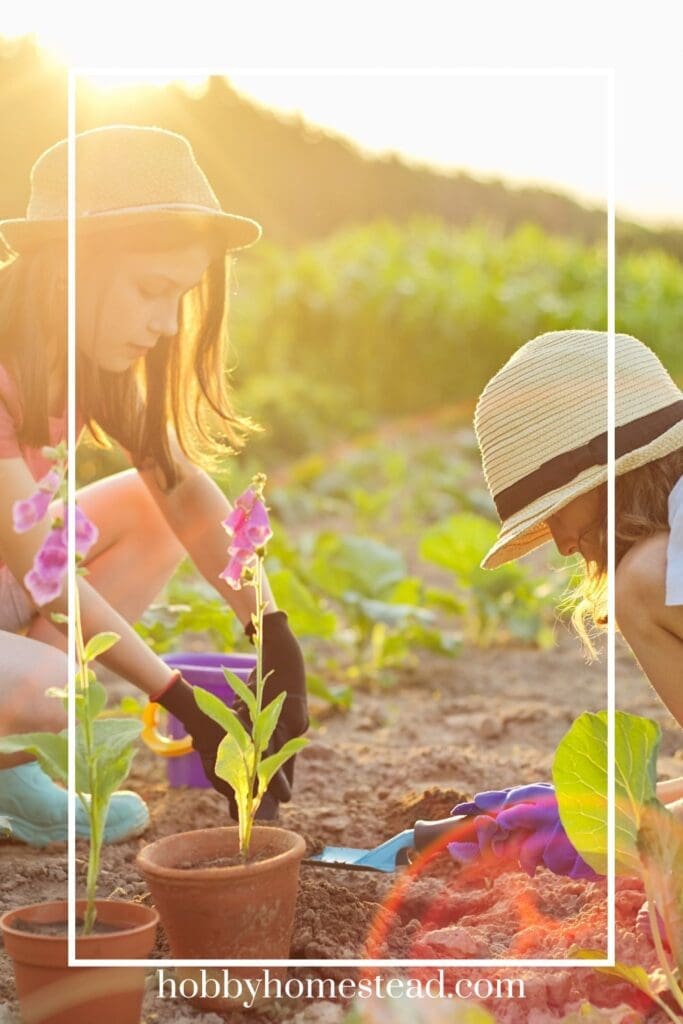Here are our top tips to plan a butterfly garden. There’s something magical about watching butterflies dance from flower to flower in your backyard.
With the right plants and a little planning, you can create a thriving space that attracts a variety of butterflies and makes your garden feel alive.
Adding a butterfly garden to your homestead not only brings vibrant beauty but also supports these vital pollinators who’ve been struggling in recent years.
Why Build a Butterfly Garden?
Butterflies are more than just a pretty sight—they’re hardworking pollinators and an important part of our ecosystem. In recent years, we’ve seen a troubling decline in butterfly populations, making butterfly gardening more than just a hobby; it’s a way to give back to nature.
For homesteaders, butterfly gardens do more than attract these winged wonders. They invite other beneficial insects, support organic gardening practices, and add a natural beauty that enhances your space. Plus, it’s incredibly rewarding to know you’re helping species like the monarch butterfly or the pipevine swallowtail flourish.

Tips for Designing Your Butterfly Haven
Find the Perfect Spot
Butterflies love the sun! They need the warmth to regulate their body temperature, so pick a sunny area for your garden. A sunny spot with well-drained soil is a great place to start.
Offer a Drink Station
Butterflies don’t sip from deep ponds or birdbaths—they prefer shallow water. Try adding shallow puddles filled with damp sand or flat stones where water can pool. This is their version of a hydration station!
Plant for All Stages of Life
A successful butterfly garden isn’t just about nectar. It’s also about providing butterfly host plants that give caterpillars a place to feed and grow. Think milkweed for monarch caterpillars or spicebush for the spicebush swallowtail.
Create a Buffet of Nectar-Rich Flowers
Butterflies are always on the lookout for bright, nectar-filled blooms. Plants like purple coneflower, black-eyed susan, and bee balm are irresistible to them. Plus, these flowers add a splash of color to your garden from early spring to late fall.
Go Native
Native plants are like old friends to butterflies—they recognize them and thrive on them. In the United States, options like swamp milkweed, joe pye weed, and new england aster are excellent choices.

Must-Have Plants for Your Butterfly Garden
If you’re wondering where to start, here’s a list of my favorite butterfly-friendly plants that never fail to attract a wide range of butterflies.
Butterfly Bush (Buddleia). This flowering shrub is a classic choice, known for its fragrant blooms that butterflies can’t resist.
Purple Coneflower (Echinacea purpurea). A standout for its nectar-rich flowers and bright, bold petals.
Butterfly Weed (Asclepias tuberosa). This vibrant orange plant is as beautiful as it is beneficial.
Joe Pye Weed. A tall plant that’s a magnet for butterflies in late summer.
Black-Eyed Susan (Rudbeckia hirta). These cheerful blooms light up your garden and attract hungry butterflies all season long.
Anise Hyssop. A lesser-known gem with fragrant flowers that are perfect for butterflies and beneficial insects alike.
How to Keep Your Garden Thriving
Once your butterfly garden is planted, caring for it is easy. Butterflies will naturally flock to your garden if you’ve provided the right plants, but a few small steps can make all the difference.
Deadhead your flowers to keep them blooming longer. Butterflies rely on consistent nectar sources, especially in late summer and early spring when food can be scarce.
Skip the pesticides. Even organic sprays can harm butterfly larvae or adults. Let nature handle pest control—it’s a good idea for your garden and the planet.
Keep an eye out for new plants to add. Gardens are ever-evolving, and a few fresh additions each year can keep things interesting for both you and your butterflies.
Why You’ll Love Having a Butterfly Garden
A butterfly garden is more than just a collection of plants—it’s a small but meaningful way to connect with nature. Watching a red admiral or monarch butterfly flutter through your garden is a daily reminder of the beauty and resilience of the natural world.

Plant, Play, and Pollinate: Building a Butterfly Garden with Kids
Having younger kids involved makes butterfly gardening even more engaging and family friendly. It’s a great way to bond, teach children about nature, and cultivate a love for gardening and pollinators.
Equipment for Creating a Butterfly Garden with Kids
Gardening Gloves (Child-Sized). Protect little hands from dirt, plants, and insects while keeping the gardening fun!
Small Shovel or Trowel. Perfect for little hands to dig holes for plants and mix soil.
Watering Can. A child-sized watering can with a gentle spout makes watering easy and fun.
Rake. A small, lightweight rake for kids to help smooth the soil after planting.
Garden Kneeler or Mat. To make planting more comfortable, especially if the ground is rough or hard.
Plant Markers. Use to label each plant; kids can enjoy writing the plant names or decorating the markers!
Garden Tools Set (Optional). A set of child-sized tools that might include a spade, hand rake, and hoe—perfect for kids to use while you work together.
Shallow Dish or Puddle Tray. A small tray for water to attract butterflies and keep them hydrated.
Small Hand Pruners (Adult Supervision). For cutting back plants or deadheading flowers (only for older children or under supervision).
Soil. Healthy, well-drained soil—you can buy pre-mixed or make your own using compost and garden soil.
Compost (Optional). Adding compost helps enrich the soil and improve plant growth.
Butterfly-Friendly Plants. Nectar-rich flowers, host plants like milkweed, and native plants such as black-eyed susan, bee balm, and butterfly weed.
Garden Stakes or Plant Supports. To help support taller plants like joe pye weed or swamp milkweed.
Garden Hose or Sprayer. A hose with a gentle spray setting to water the garden without disturbing the plants.
Bucket or Wheelbarrow. For transporting soil, compost, and plants.
Garden Journal. To track progress and note butterfly sightings; kids can make it a fun scrapbook.
Sunscreen and Hats. Protect yourself and your kids while spending time in the garden on sunny days.
Bug Repellent (Optional). Non-toxic, kid-friendly repellent to keep away any unwanted insects.
Step-by-Step Guide to Building a Butterfly Garden with Kids
Step 1: Pick the Perfect Spot
Explain how to choose a sunny area that butterflies will love. Encourage kids to look for a spot with full sun where they can sit and watch the butterflies once the garden is blooming.
Step 2: Plan Your Garden Together
Make it interactive.
- Let kids sketch a colorful garden plan.
- Talk about including nectar plants, butterfly host plants, and water sources like shallow puddles.
- Mention some kid-friendly options like purple coneflower, black-eyed susan, or butterfly weed.
Step 3: Shop for Plants
Take the kids plant shopping.
Look for native plants like milkweed or joe pye weed—explain that these are important for butterflies in your area.
Make it fun by letting them pick flowers with bright colors or ones they think are pretty.
Step 4: Prepare the Soil
Give them small tools and show them how to dig and loosen the soil. Explain why well-drained soil is important. If it’s not ideal, talk about adding compost or garden soil to help the plants grow.
Step 5: Plant Your Butterfly Garden
Let kids place the plants in the garden bed before planting them.
Show them how to dig a hole and gently press the soil around the plant.
Mention how they’re helping create food for butterflies and beneficial insects!
Step 6: Add Water and Decor
Encourage kids to help water the plants and talk about why water is essential for growth.
Add a shallow puddle or a small dish filled with water and stones for thirsty butterflies.
Suggest decorating the garden with painted rocks or small signs with butterfly facts.
Step 7: Watch, Wait, and Learn
Explain that butterflies take time to arrive, but their job now is to watch and learn.
Encourage keeping a journal of the different butterfly species they spot.
Add a fun activity like identifying butterflies like the monarch, red admiral, or pearl crescent.
Tips for Keeping Kids Engaged
Make it a game. Who can spot the first butterfly?
Learn together. Use books or apps to identify plants and butterflies.
Grow edible plants. Incorporate edible plants like herbs so kids can taste what they grow.
Encourage curiosity. Ask questions like, “Why do butterflies like this flower?”
Creating a butterfly garden with your little ones isn’t just about planting flowers. It’s about growing memories, fostering curiosity, and making a real difference for our pollinator friends.
With a little patience and care, your garden will soon be buzzing with life and color. Grab your shovels, gather your kids, and get started on this magical adventure.
Whether you have a sprawling homestead or a small garden, adding these great plants can transform your space into a haven for butterflies, caterpillars, and other wildlife.
References
Garden Design. 25 Butterfly Garden Plants & Flowers.
HGTV. Add These Flowers to Attract Butterflies to Your Garden.


